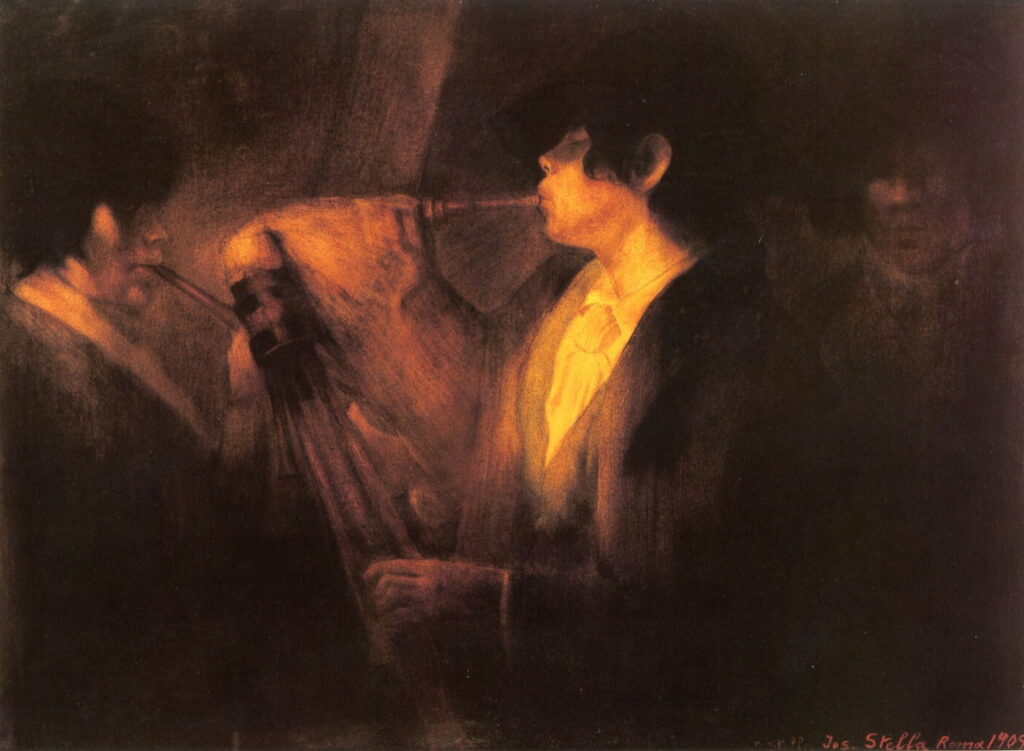Reading visual art: 133 Bagpipes

No one knows when the aulos was fitted with an airtight bag to become a set of bagpipes, although there are claims of an ancient origin that could date back to 1000 BCE in Anatolia. During the Middle Ages, instruments resembling modern bagpipes appear to have spread throughout western Europe, and appear in visual art of the time. In addition to their distinctive airtight bag, most consist of at least two reed pipes, a chanter on which the melody is played, and one or more drones that emit a continuous note. The bag is inflated by blowing through a blowpipe, and its air is blown through the reeds by compressing the bag under an arm.
While today they’re most commonly associated with traditional Scottish and Irish music, they remain of importance to folk music throughout Europe and the Middle East, from Sweden to Iran.
Among the oldest depictions of bagpipes are those of death and its dance.
Bernt Notke (1440–1509), The Danse Macabre (1475-99), oil on canvas, 160 x 750 cm, Eesti Kunstimuuseum, Tallinn, Estonia. Wikimedia Commons.
Among the dignitaries in Bernt Notke’s painting of The Danse Macabre from 1475-99 are a church leader, king, queen, cardinal, and a secular noble. At the left, one of the devilish figures sits playing a set of bagpipes, giving rise to the motif of the figure of death playing a musical instrument, later becoming a fiddle.
James Tissot (1836–1902), The Dance of Death (Way of Flowers, Way of Tears) (1860), oil on canvas, 37.2 x 122.4 cm, Rhode Island School of Design, Providence, RI. Wikimedia Commons.
Early in his career, James Tissot researched mediaeval paintings, as a result of which he painted a series including this Dance of Death or the Way of Flowers, Way of Tears, one of his first successes at the Salon in 1860. Two figures at the front of his cavalcade are playing bagpipes for the others to dance to.
Just as with reed pipes and the aulos, bagpipes became an instrument played by shepherds. They were a recurrent motif in the paintings of Hieronymus Bosch.
Hieronymus Bosch (c 1450–1516), The Adoration of the Magi (centre panel) (The Adoration of the Magi) (1490-1500) (CR no. 9), oil on oak panel, 138 cm x 138 cm overall when open, Museo Nacional del Prado, Madrid. Wikimedia Commons.
In the Adoration scene on the central panel of Bosch’s Adoration of the Magi, there’s a shepherd serenading the Holy Family. As shown in the detail below, a group of shepherds are engaged in climbing a tree behind and to the right of the shed. Two, a man and a woman clutching a set of bagpipes, are leaning over the thatched roof to view the scene below, and three more are underneath them.
Hieronymus Bosch (c 1450–1516), The Adoration of the Magi (detail) (centre panel) (The Adoration of the Magi) (1490-1500) (CR no. 9), oil on oak panel, 138 cm x 138 cm overall when open, Museo Nacional del Prado, Madrid. Wikimedia Commons.
Hieronymus Bosch (c 1450–1516), The Garden of Earthly Delights (right panel, detail) (c 1495-1505), oil on oak panel, central panel 190 × 175 cm, each wing 187.5 × 76.5 cm, Museo Nacional del Prado, Madrid. Wikimedia Commons.
The ‘garden’ of Hell in the right panel of Bosch’s Garden of Earthly Delights shows many figures being mutilated and tormented. On the near-black frozen surface of the river behind, there are skaters, one of whom has fallen through the ice. Another is tied to his ice craft. Above them is the Tree-Man (detail below), a unique structure to Bosch that appears in one of his drawings. At its top, on a circular disc, is a strange portmanteau object, which looks to be a cross between bagpipes and an alchemical vessel from an alembic.
Hieronymus Bosch (c 1450–1516), The Garden of Earthly Delights (right panel, detail) (c 1495-1505), oil on oak panel, central panel 190 × 175 cm, each wing 187.5 × 76.5 cm, Museo Nacional del Prado, Madrid. Wikimedia Commons.
Hieronymus Bosch (c 1450–1516), The Haywain Triptych (exterior) (c 1510-16), oil on oak panel, left wing 136.1 x 47.7 cm, central panel 133 × 100 cm, right wing 136.1 × 47.6 cm, Museo Nacional del Prado, Madrid. Wikimedia Commons.
The exterior of Bosch’s Haywain Triptych shows an older man walking from left to right along a narrow path passing through meadows. Behind him, on the left, three robbers are tying another traveller to a tree, having stolen his outer clothing and his pack. They are armed with a crossbow and pikes, which rest on the ground by them. On the right, in the distance, a man and a woman are dancing amid their flock of sheep, to the music provided by a bagpiper, who is sat underneath another tree with a large box fixed to its trunk.
For Pieter Brueghel the Elder, the bagpipes were the instrument for folk dancing.
Pieter Brueghel the Elder (1526/1530–1569), The Magpie on the Gallows (1568), oil on oak, 46 x 51 cm, Hessisches Landesmuseum Darmstadt, Darmstadt, Germany. Wikimedia Commons.
In his Magpie on the Gallows from 1568, shown in the detail below, country people are dancing to the sound of bagpipes in a fairly normal rustic feast.
Pieter Brueghel the Elder (1526/1530–1569), The Magpie on the Gallows (detail) (1568), oil on oak, 46 x 51 cm, Hessisches Landesmuseum Darmstadt, Darmstadt, Germany. Wikimedia Commons.
Nicolas Poussin (1594-1665), Landscape with a Calm (c 1651), oil on canvas, 97 x 131 cm, J. Paul Getty Museum, Los Angeles. Digital image courtesy of the Getty’s Open Content Program.
In Nicolas Poussin’s wonderful Landscape with a Calm from about 1651, at the back of the glassy lake are two men tending a flock of sheep and herd of cattle. As shown in the detail below, one of them is playing bagpipes.
Nicolas Poussin (1594-1665), Landscape with a Calm (detail) (c 1651), oil on canvas, 97 x 131 cm, J. Paul Getty Museum, Los Angeles. Digital image courtesy of the Getty’s Open Content Program.
Bagpipers then appeared less frequently in paintings, until Joseph Stella revived them in the early twentieth century. Stella had been born and brought up in the village of Muro Lucano in southern Italy, where he was used to local bagpipers. After making a promising start to his painting career in New York, he grew unhappy, and in 1909 returned to Italy.
Joseph Stella (1877–1946), The Bagpipers (1909), mixed media on paper on board, 66.7 x 90.2 cm, Private collection. The Athenaeum.
Despite his first exposure to Modernism there, Stella painted The Bagpipers when he was in Rome in 1909.
Joseph Stella (1877–1946), The Crèche (1929-33), oil on canvas, 154.9 x 195.6 cm, Newark Museum, Newark, NJ. Wikimedia Commons.
The Crèche from 1929-33 is his later ingenious framing of the Nativity. At its centre is the Nativity ‘crib’ so often shown at Christmas, with an audience who appear to have been drawn from Stella’s home in Italy, playing traditional bagpipes in homage.
Bagpipes have thus accompanied the whole of life, from birth, through folk dancing, to death.



